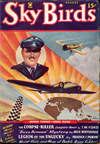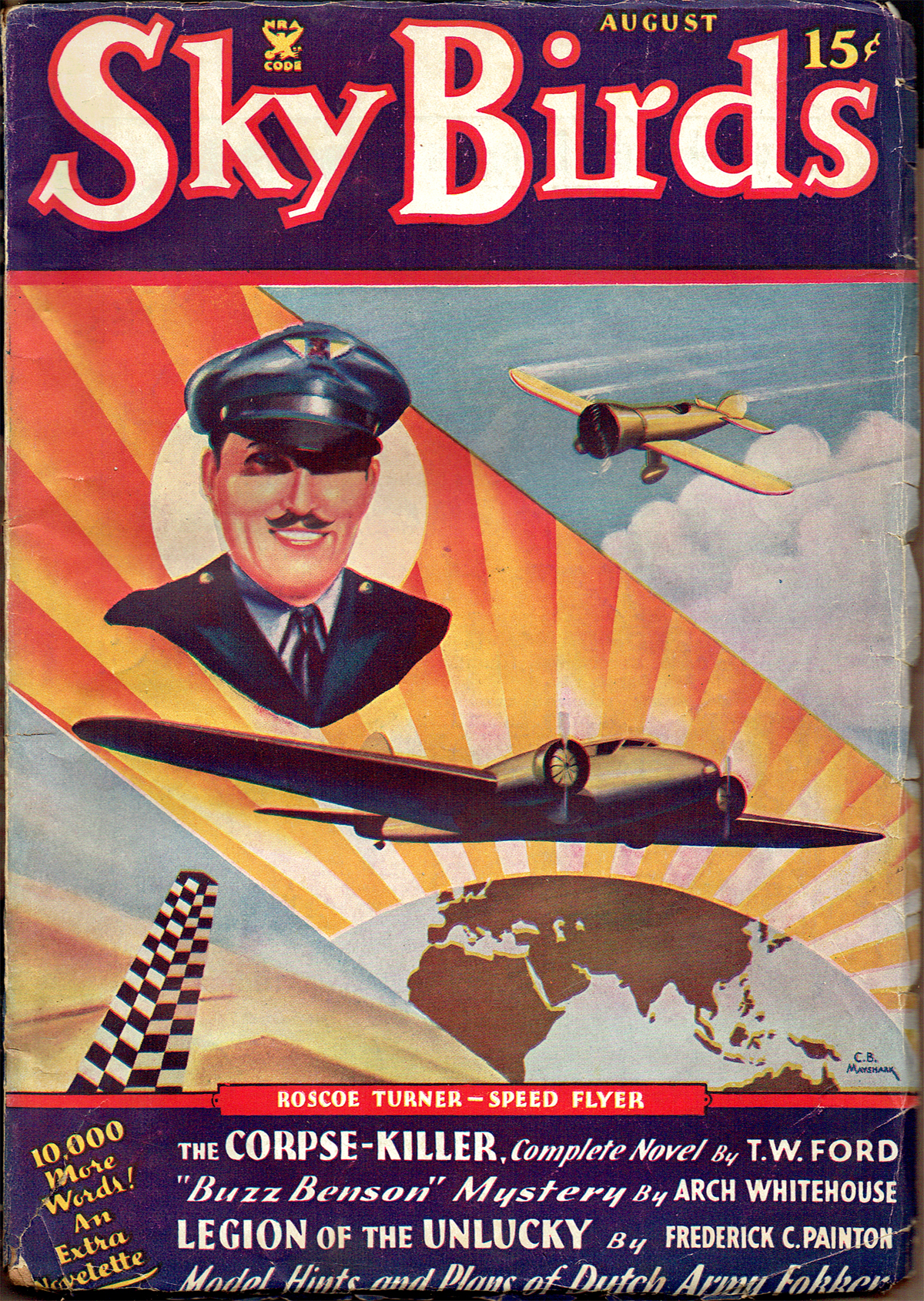“Roscoe Turner—Speed Flyer” by C.B. Mayshark
THIS May we are once again celebrating the genius that is C.B. Mayshark! Mayshark took over the covers duties for Sky Birds with the July 1934 and would paint all the remaining covers until it’s last issue in December 1935. At the start of his run, Sky Birds started featuring a different combat maneuver of the war-time pilots. Mayshaerk changed things up for the final four covers. Sky Birds last four covers each featured a different aviation legend. The subject of the August 1935 cover was speed flyer Roscoe Turner!
Roscoe Turner—Speed Flyer
The Story Behind This Month’s Cover
 OCTOBER 20, 1934, was a big day for aviation enthusiasts the world over. For at Mildenhall, England, a score of airmen were turning up powerful motors, waiting for the flagman to wave the signal which would start them off on the 11,323-mile grind to Melbourne, Australia.
OCTOBER 20, 1934, was a big day for aviation enthusiasts the world over. For at Mildenhall, England, a score of airmen were turning up powerful motors, waiting for the flagman to wave the signal which would start them off on the 11,323-mile grind to Melbourne, Australia.
Among the ships entered for the race was a Boeing 247-D, piloted by a certain Roscoe Turner who, along with Clyde Pangborn, had elected to take a shot at the most hazardous and thrilling adventure in aviation history—the MacRobertson Trophy Race.
The name of Roscoe Turner was not new to the thousands of people the world over who read the list of entrants for the big race on the morning of October 20. Indeed, Turner had been a popular air hero for some years. He was not outstanding as a spectacular and breath-taking pilot who took long chances and always managed to get through by the skin of his teeth—but more as the type who is cool, methodical and well-schooled in the fundamental principals of aeronautics. Even when he was behind the controls of one of his various racing ships, Turner always knew what he was going to do next.
For Roscoe Turner had learned about airplanes and how to fly them from the ground up. His career in the air began in March, 1918, when he transferred from the U.S. Ambulance Service to the Army Air Service’ and was commissioned a second lieutenant.
Turner served overseas for ten months with the second army, and then with the third army at Coblenz, Germany, following the Armistice. He was discharged with the rank of first lieutenant, U.S. Army Air Service, in 1919, and returned home to engage in civil and commercial aviation in the United States. Turner’s Army record was not particulary outstanding, although he did win a promotion. He was saving himself, as it were, for a more important role—that of an accomplished and publicized peacetime airman.
However, the desire for military duty soon overcame him, and he joined with the California National Guard, where he served as captain from 1925 to 1927. He was later made personal aid to Governor Rolph of California, for whom he acted as pilot, and was promoted to the rank of colonel.
Turner’s records and accomplishments are too numerous to record here. However, it should be stated that he has held almost every important racing and commercial aircraft record in the United States at one time or another. Also, he was the first pilot to lower a plane by parachute successfully, although it had been attempted before. The German wartime Gotha which was used in the filming of the motion picture, “Hell’s Angels,” was flown and owned by Turner. For a time, he always carried with him in his plane a lion which he had acquired when it was a cub and had trained himself. However, the lion had to be dispensed with when it became too big.
And so it can be seen that up until October 20, 1934, Colonel Roscoe Turner was merely another one of the numerous well-known American aviators. But fate had decreed that he was to accomplish something bigger and bettor than the average airman can claim.
The rest is written into aviation history and is common knowledge to everyone who reads the newspapers. Turner and Pangborn finished third in the MacRobertson Trophy Race, and copped third-place prize money amounting to $7,500. Their time was 93 hours, 5 minutes, 15 seconds.
And so to Colonel Roscoe Turner we say, “Congratulations and happy landings!” And we know that his feats in the future will equal, if not surpass, his accomplishments of the past several years.

“Roscoe Turner—Speed Flyer” by C.B. Mayshark
Sky Birds, August 1935




